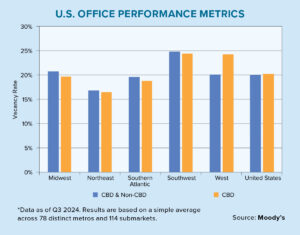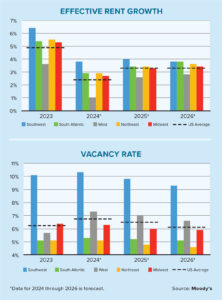The office, from the mortgage lender’s perspective, is now a four-letter word. This pithy lamentation about the office sector came from Varuna Bhattacharyya, a real estate finance partner with Bryan Cave Leighton Paisner law firm in New York City.
“For me, it’s that feeling of the unknown, of uncertainty. We’re not really sure if there is another shoe that is going to drop or how long this is going to last.”
– Varuna Bhattacharyya, real estate finance partner, Bryan Cave Leighton Paisner
Bhattacharyya, who represents a variety of national and multinational banking institutions, says that commercial office lending was already in the midst of a pullback, with fewer originations being completed and some defaults occurring when the recent banking crisis hit. “For me, it’s that feeling of the unknown, of uncertainty,” Bhattacharyya says. “We’re not really sure if there is another shoe that is going to drop or how long this is going to last. I think we are all trying to have a wait-and-see attitude, but that is obviously always hard.”
Currently, everyone involved with the office sector appears to be nervous — and for good reason. This past February, Columbia Property Trust (which owns office buildings in several cities, including New York, Boston and San Francisco) defaulted on about $1.7 billion in mortgage debt on seven major properties. At about the same time, Brookfield Corp., one of the world’s largest property owners, defaulted on $784 million in loans backed by two skyscrapers in downtown Los Angeles.
These two events were major shocks to the commercial real estate system. Others have followed, including Blackstone’s default on a $562.5 million bond in early March. Experts are worried that once companies start walking away from loans, a flood of defaults will follow. In turn, this will impact lenders and create a negative loop. Also playing a role is $1.5 trillion in commercial real estate debt that is set to mature over the next three years.
According to Bloomberg, some of these default decisions may have been negotiation tactics to extend payment periods or improve the terms of loans that were no longer viable. Whatever the C-suite machinations behind the moves, the result has sent a clear warning sign to the office market at large, which is still experiencing major difficulties due to the lingering effects of COVID-19 and a shift in the employment culture that has embraced working from home.
Of course, such worries didn’t start in 2023. According to Fast Company magazine, only 28% of Manhattan office workers had returned to their desks by October 2021. And one-third of the major employers surveyed by the Partnership for New York City at that time expected to need less office space over the next five years.
It now seems reasonably clear that there was a paradigm shift in the office sector happening before our eyes, and no one really knew its size or scope. We still don’t. But no shift of this size can take place without repercussions.
A September 2022 research paper titled “Work From Home and the Office Real Estate Apocalypse” by professors at New York University and Columbia University may prove to be more prescient than many thought at the time. The authors were early in the process of analyzing the potential impact of the work-from-home movement on office real estate.
There are many caveats in the paper, but the bottom line is that by 2029, one scenario laid out by the researchers was that New York City office values could fall by 39%, or $50 billion. Nationally, they estimate that pandemic-related disruptions around remote work could lead to office-value declines of about $454 billion. If the authors are correct — and that is a big if — then the damage to the industry has only begun and many more defaults lie ahead.
New York University economics professor Lawrence White points out that property owners are reluctant to write down the value of an asset, so current prices may not fully reflect the experiences of the past three years. White has walked around Midtown Manhattan enough during business hours to know that the density of people and level of activity aren’t what they were a few years ago.
“It doesn’t surprise me that companies who occupy office spaces are thinking, ‘Well, geez, if my people are going to be coming in only three days a week, we need less space,’” White says. “New York financial companies and investment banks have been trying to get their workforce back into the office five days a week for more than a year. And as best as I can tell, they are not succeeding.”
If less space is needed for office workers of the future, not all is lost. New York City, for example, previously converted office buildings into housing, including nearly 13 million square feet in Lower Manhattan between 1995 and 2006. White wants city officials to embrace the current crisis as another opportunity to create more housing in the heart of the city.
“I understand it’s not that easy to convert office towers to residential housing. And is it going to be as profitable as renting to an insurance or banking firm? Probably not,” White says. “So, that means the building owners take a hit. But, man, you solve a lot of problems expanding the city’s housing supply and reviving those ancillary services such as restaurants, stores and salons. It takes a lot of effort on the part of the mayor’s office and the city council to make it happen. But I have my hopes.” ●








